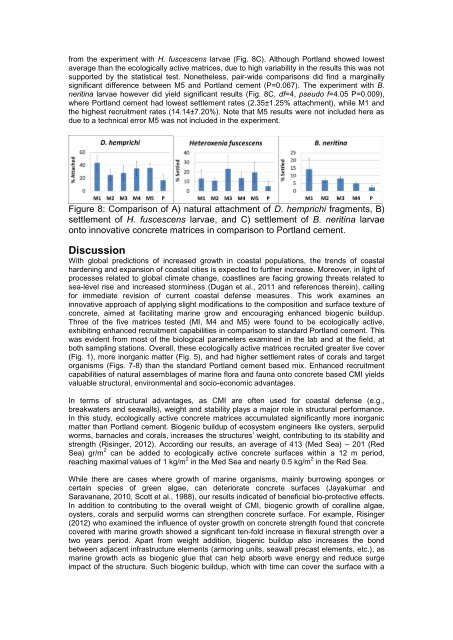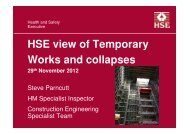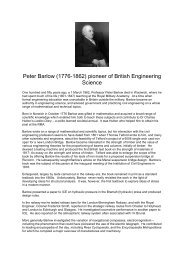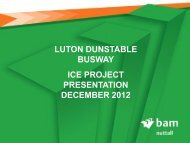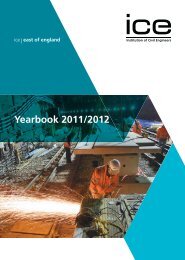Ecologically Active - Institution of Civil Engineers
Ecologically Active - Institution of Civil Engineers
Ecologically Active - Institution of Civil Engineers
Create successful ePaper yourself
Turn your PDF publications into a flip-book with our unique Google optimized e-Paper software.
from the experiment with H. fuscescens larvae (Fig. 8C). Although Portland showed lowest<br />
average than the ecologically active matrices, due to high variability in the results this was not<br />
supported by the statistical test. Nonetheless, pair-wide comparisons did find a marginally<br />
significant difference between M5 and Portland cement (P=0.067). The experiment with B.<br />
neritina larvae however did yield significant results (Fig. 8C, df=4, pseudo f=4.05 P=0.009),<br />
where Portland cement had lowest settlement rates (2.35±1.25% attachment), while M1 and<br />
the highest recruitment rates (14.14±7.20%). Note that M5 results were not included here as<br />
due to a technical error M5 was not included in the experiment.<br />
Figure 8: Comparison <strong>of</strong> A) natural attachment <strong>of</strong> D. hemprichi fragments, B)<br />
settlement <strong>of</strong> H. fuscescens larvae, and C) settlement <strong>of</strong> B. neritina larvae<br />
onto innovative concrete matrices in comparison to Portland cement.<br />
Discussion<br />
With global predictions <strong>of</strong> increased growth in coastal populations, the trends <strong>of</strong> coastal<br />
hardening and expansion <strong>of</strong> coastal cities is expected to further increase. Moreover, in light <strong>of</strong><br />
processes related to global climate change, coastlines are facing growing threats related to<br />
sea-level rise and increased storminess (Dugan et al., 2011 and references therein), calling<br />
for immediate revision <strong>of</strong> current coastal defense measures. This work examines an<br />
innovative approach <strong>of</strong> applying slight modifications to the composition and surface texture <strong>of</strong><br />
concrete, aimed at facilitating marine grow and encouraging enhanced biogenic buildup.<br />
Three <strong>of</strong> the five matrices tested (MI, M4 and M5) were found to be ecologically active,<br />
exhibiting enhanced recruitment capabilities in comparison to standard Portland cement. This<br />
was evident from most <strong>of</strong> the biological parameters examined in the lab and at the field, at<br />
both sampling stations. Overall, these ecologically active matrices recruited greater live cover<br />
(Fig. 1), more inorganic matter (Fig. 5), and had higher settlement rates <strong>of</strong> corals and target<br />
organisms (Figs. 7-8) than the standard Portland cement based mix. Enhanced recruitment<br />
capabilities <strong>of</strong> natural assemblages <strong>of</strong> marine flora and fauna onto concrete based CMI yields<br />
valuable structural, environmental and socio-economic advantages.<br />
In terms <strong>of</strong> structural advantages, as CMI are <strong>of</strong>ten used for coastal defense (e.g.,<br />
breakwaters and seawalls), weight and stability plays a major role in structural performance.<br />
In this study, ecologically active concrete matrices accumulated significantly more inorganic<br />
matter than Portland cement. Biogenic buildup <strong>of</strong> ecosystem engineers like oysters, serpulid<br />
worms, barnacles and corals, increases the structures’ weight, contributing to its stability and<br />
strength (Risinger, 2012). According our results, an average <strong>of</strong> 413 (Med Sea) – 201 (Red<br />
Sea) gr/m 2 can be added to ecologically active concrete surfaces within a 12 m period,<br />
reaching maximal values <strong>of</strong> 1 kg/m 2 in the Med Sea and nearly 0.5 kg/m 2 in the Red Sea.<br />
While there are cases where growth <strong>of</strong> marine organisms, mainly burrowing sponges or<br />
certain species <strong>of</strong> green algae, can deteriorate concrete surfaces (Jayakumar and<br />
Saravanane, 2010, Scott et al., 1988), our results indicated <strong>of</strong> beneficial bio-protective effects.<br />
In addition to contributing to the overall weight <strong>of</strong> CMI, biogenic growth <strong>of</strong> coralline algae,<br />
oysters, corals and serpulid worms can strengthen concrete surface. For example, Risinger<br />
(2012) who examined the influence <strong>of</strong> oyster growth on concrete strength found that concrete<br />
covered with marine growth showed a significant ten-fold increase in flexural strength over a<br />
two years period. Apart from weight addition, biogenic buildup also increases the bond<br />
between adjacent infrastructure elements (armoring units, seawall precast elements, etc.), as<br />
marine growth acts as biogenic glue that can help absorb wave energy and reduce surge<br />
impact <strong>of</strong> the structure. Such biogenic buildup, which with time can cover the surface with a


